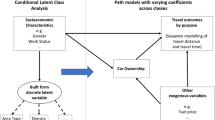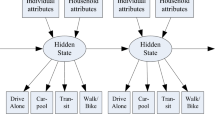Abstract
This study introduces an extended version of a standard multilevel cross-classified logit model which takes co-variations into account, i.e., variations jointly caused by two or more unobserved factors. Whilst focusing on mode choice behavior, this study deals with four different types of variation: spatial variations, inter-individual variations, intra-individual variations and co-variations between inter-individual and spatial variations. Such co-variations represent individual-specific spatial effects, reflecting different responses to the same space among individuals, which may for example be due to differences in their spatial perceptions. In our empirical analysis, we use data from Mobidrive (a continuous six-week travel survey) to clarify the existence of co-variation effects by comparing two models with and without co-variation terms. The results of this analysis indicate that co-variations certainly exist, especially for utility differences in bicycle and public transport use in comparison with car use. We then sequentially introduce four further sets of explanatory variables, examine the sources of behavioral variations and determine what types of influential factors are dominant in mode choice behavior.





Similar content being viewed by others
References
Axhausen, K.W., Zimmermann, A., Schönfelder, S., Rindsfüser, G., Haupt, T.: Observing the rhythms of daily life: a six-week travel diary. Transportation 29, 95–124 (2002)
Ben-Akiva, M., Bolduc, D., Walker, J. Specification, identification, & estimation of the logit kernel (or continuous mixed logit) model, Working Paper, Department of Civil Engineering, MIT (2001)
Bhat, C.R.: A multi-level cross-classified model for discrete response variables. Transp. Res. Part B 34, 567–582 (2000)
Bhat, C.R.: Quasi-random maximum simulated likelihood estimation of the mixed multinomial logit model. Transp. Res. Part B 35, 677–693 (2001)
Bhat, C.R., Zhao, H.: The spatial analysis of activity stop generation. Transp. Res. Part B 36, 557–575 (2002)
Cherchi, E., Cirillo, C. A mixed logit mode choice model on panel data: accounting for systematic and random variations on responses and preferences. Paper presented at the 87th Annual Meeting of the Transportation Research Board, Washington, DC, January, 2008 (DVD-ROM) (2008)
Chikaraishi, M., Fujiwara, A., Zhang, J., Axhausen, K.W.: Exploring variation properties of departure time choice behavior using multilevel analysis approach. Transp. Res. Rec. 2134, 10–20 (2009)
Chikaraishi, M., Zhang, J., Fujiwara, A., Axhausen, K.W. Exploring variation properties of time use behavior based on a multilevel multiple discrete-continuous extreme value model. Transp. Res. Rec. (in press) (2010)
Cirillo, C., Axhausen, K.W.: Evidence on the distribution of values of travel time savings from a six-week diary. Transp. Res. A 40, 444–457 (2006)
Gärling, T., Axhausen, K.W.: Introduction: habitual travel choice. Transportation 30, 1–11 (2003)
Gelman, A., Carlin, J.B., Stern, H.S., Rubin, D.B.: Bayesian Data Analysis, 2nd edn. Chapman & Hall/CRC, Boca Raton (2004)
Geweke, J.: Evaluating the accuracy of sampling-based approaches to the calculation of posterior moments. In: Bernardo, J.M., Berger, J.O., Dawid, A.P., Smith, A.F.M. (eds.) Bayesian Statistics 4, pp. 169–193. Oxford University Press, Oxford (1992)
Goldstein, H.: Multilevel statistical models, 3rd edn. Edward Arnold, London (2003)
Goulias, K.G.: Multilevel analysis of daily time use and time allocation to activity types accounting for complex covariance structures using correlated random effects. Transportation 29, 31–48 (2002)
Grilli, L., Rampichini, C.: Alternative specifications of multivariate multilevel probit ordinal response models. J. Educ. Behav. Stat. 28, 31–44 (2003)
Grilli, L., Rampichini, C.: A multilevel multinomial logit model for the analysis of graduates’ skills. Stat. Meth. Appl. 16, 381–393 (2007)
Habib, M.A., Miller, E.J. Influence of transportation access and market dynamics on property values: multilevel spatio-temporal models of housing price. Paper presented at the 87th Annual Meeting of the Transportation Research Board (CD-ROM) (2008)
Hanson, S., Huff, J.: Classification issues in the analysis of complex travel behavior. Transportation 13, 271–293 (1986)
Hanson, S., Huff, J.: Repetition and day-to-day variability in individual travel patterns: implications for classification. In: Golledge, R.G., Timmermans, H. (eds.) Behavioural Modelling in Geography and Planning, pp. 368–398. Croom Helm, London (1988)
Keane, M.P.: A note on identification in the multinomial probit model. J. Bus. Econ. Stat. 10, 193–200 (1992)
Khandker, M., Habib, N.M., Miller, E.J.: Modeling individuals’ frequency and time allocation behavior for shopping activities considering household-level random effects. Transportation Research Record. No. 1985, 78–87 (2006)
Kim, H.J., Kim, D.H., Chung, J.-H.: Weekend activity and travel behavior in a developing country: empirical study using multilevel structural equation models. Transp. Res. Rec. 1894, 99–108 (2004)
Kitamura, R.: A preliminary study on variability, invited paper. Infrastruct. Plan. Rev. 20, 1–15 (2003). (in Japanese)
Kitamura, R., Mokhtarian, P.L., Laidet, L.: A micro-analysis of land use and travel in five neighborhoods in the San Francisco Bay Area. Transportation 24, 125–158 (1997)
Kitamura, R., Yamamoto, T., Susilo, Y.O., Axhausen, K.W.: How routine is a routine? An analysis of the day-to-day variability in prism vertex location. Transp. Res. Part A 40, 259–279 (2006)
Lunn, D.J., Thomas, A., Best, N., Spiegelhalter, D.: WinBUGS—a Bayesian modelling framework: concepts, structure, and extensibility. Stat. Comput. 10, 325–337 (2000)
Pas, E.I.: Intrapersonal variability and model goodness-of-fit. Transp. Res. Part A 21, 431–438 (1987)
Pas, E.I., Sundar, S.: Intrapersonal variability in daily urban travel behavior: some additional evidence. Transportation 22, 135–150 (1995)
Pendyala, R.M. Measuring day-to-day variability in travel behavior using GPS data. Final Report DTFH61-99-P-00266., FHWA, U.S. Department of Transportation, Washington, DC (http://www.fhwa.dot.gov/ohim/gps/index.html) (1999). Accessed 4 Oct 2009
Pinheiro, J.C., Bates, D.M.: Approximations to the log-likelihood function in the nonlinear mixed-effects model. J. Comput. Graph. Stat. 4, 12–35 (1995)
Pinjari, A.R., Pendyala, R.M., Bhat, C.R., Waddell, P.A. Modeling residential sorting effects to understand the impact of the built environment on commute mode choice. Paper presented at the 86th Annual Meeting of the Transportation Research Board, Washington DC, USA (DVD-ROM) (2007)
Schönfelder, S., Axhausen, K.W.: Activity spaces: measures of social exclusion? Transp. Policy 10, 273–286 (2003)
Spiegelhalter, D.J., Best, N.G., Carlin, B.P., van der Linde, A.: Bayesian measures of model complexity and fit. J. Roy. Stat. Soc. B 64, 583–639 (2002)
Susilo, Y.O., Dijst, M. How far is too far? Travel time ratios for activity participations in the Netherlands. Presented at the 88th Annual Meeting of the Transportation Research Board, Washington, DC (CD-ROM) (2009)
Susilo, Y.O., Maat, K.: The influence of built environment to the trends in commuting journeys in the Netherlands. Transportation 34, 589–609 (2007)
Train, K. E. A comparison of hierarchical Bayes and maximum simulated likelihood for mixed logit. Working paper, Department of Economics, University of California at Berkeley, CA (2001)
Train, K.E.: Discrete Choice Methods with Simulation. Cambridge University Press, Cambridge (2003)
Weber, J., Kwan, M.-P.: Evaluating the effects of geographic contexts on individual accessibility. Urban Geograp. 24, 647–671 (2003)
Author information
Authors and Affiliations
Corresponding author
Rights and permissions
About this article
Cite this article
Chikaraishi, M., Fujiwara, A., Zhang, J. et al. Identifying variations and co-variations in discrete choice models. Transportation 38, 993–1016 (2011). https://doi.org/10.1007/s11116-010-9317-6
Published:
Issue Date:
DOI: https://doi.org/10.1007/s11116-010-9317-6




